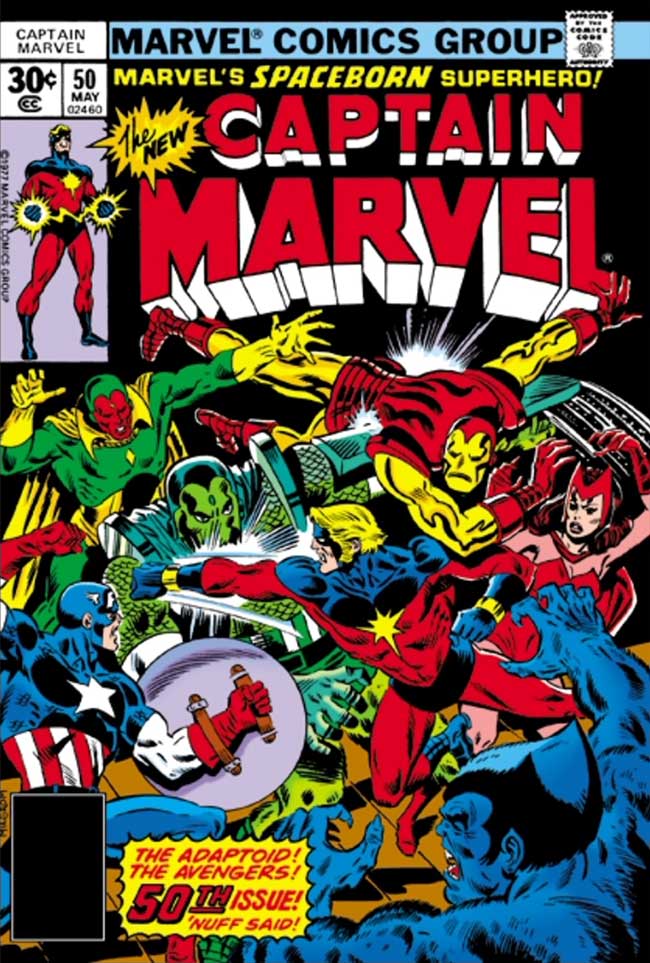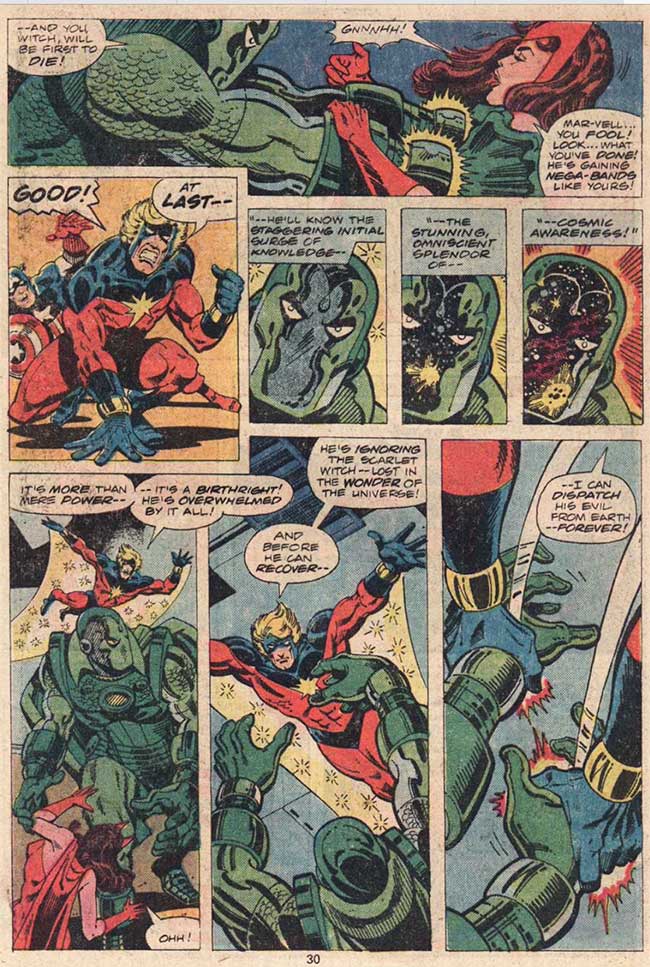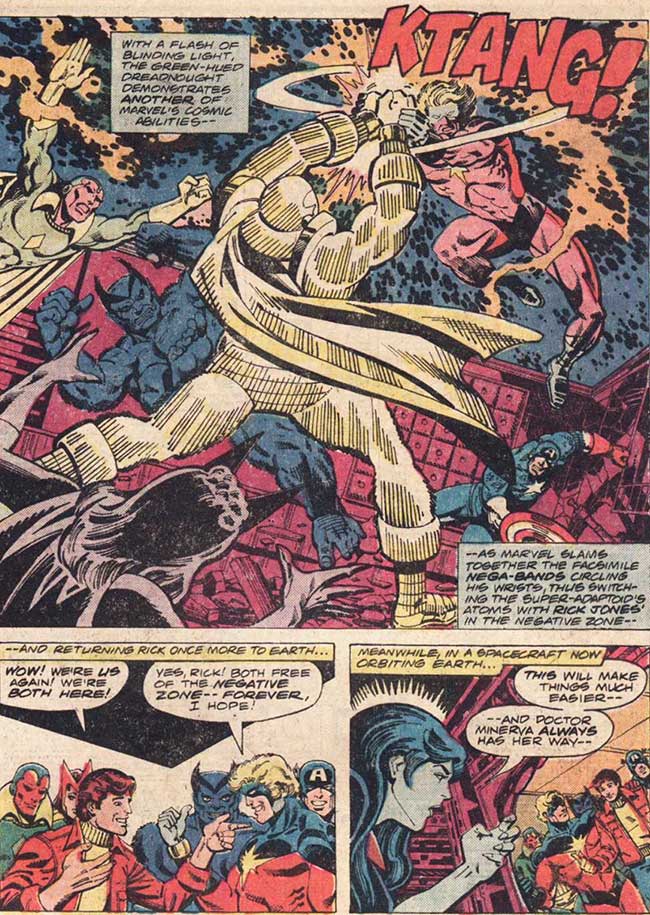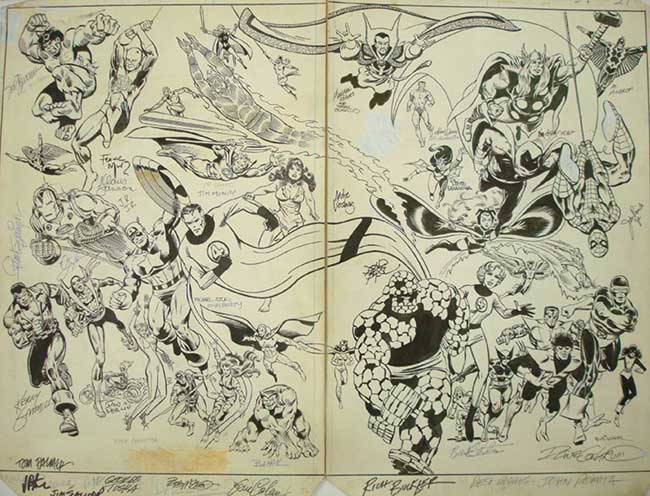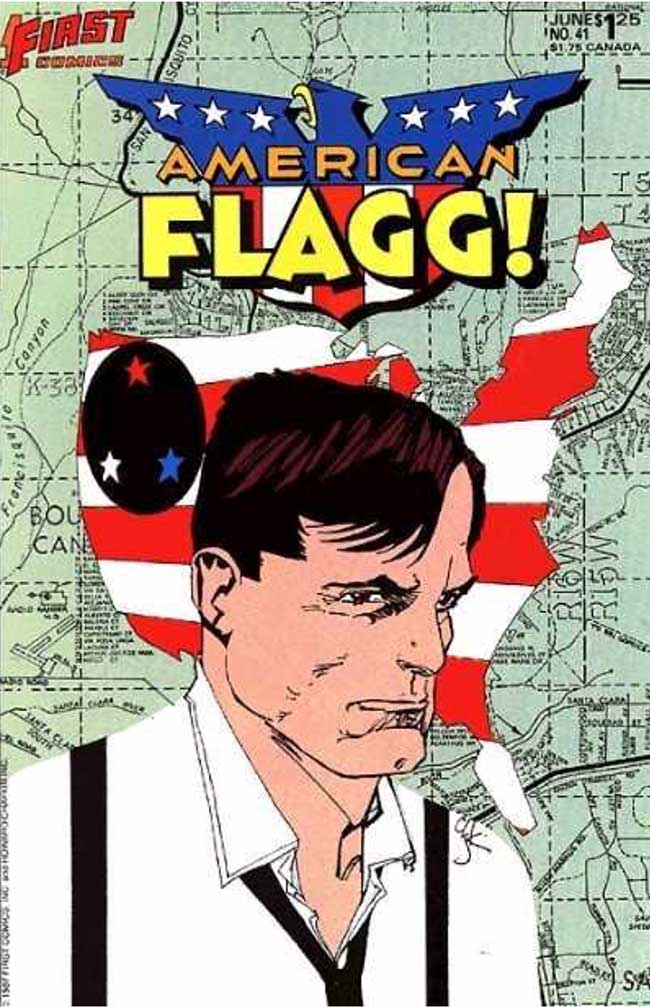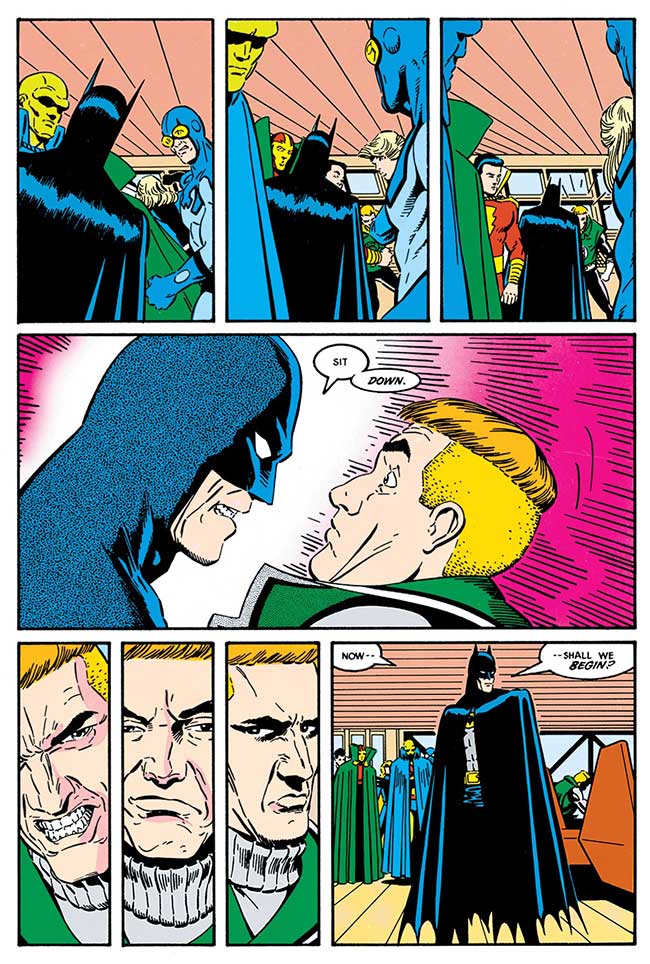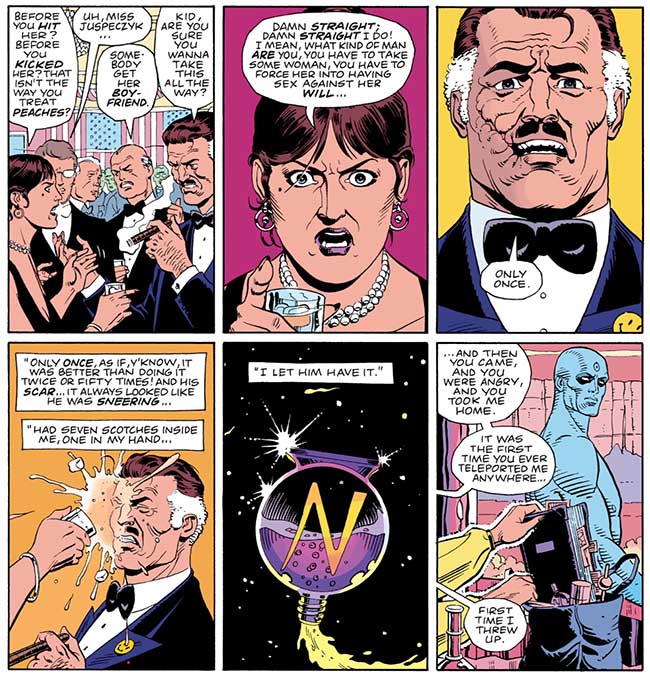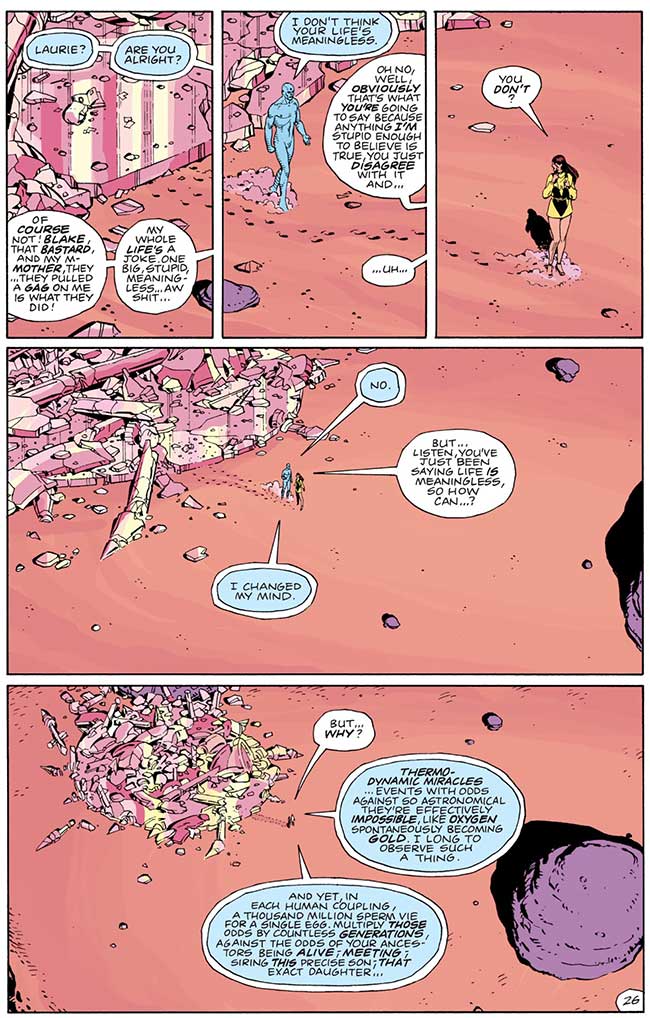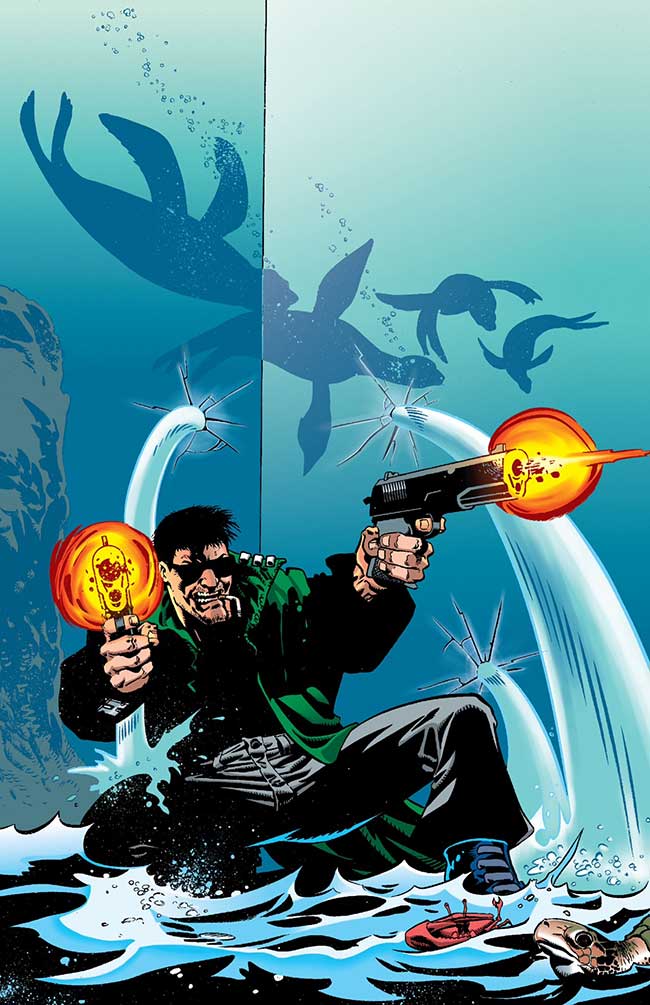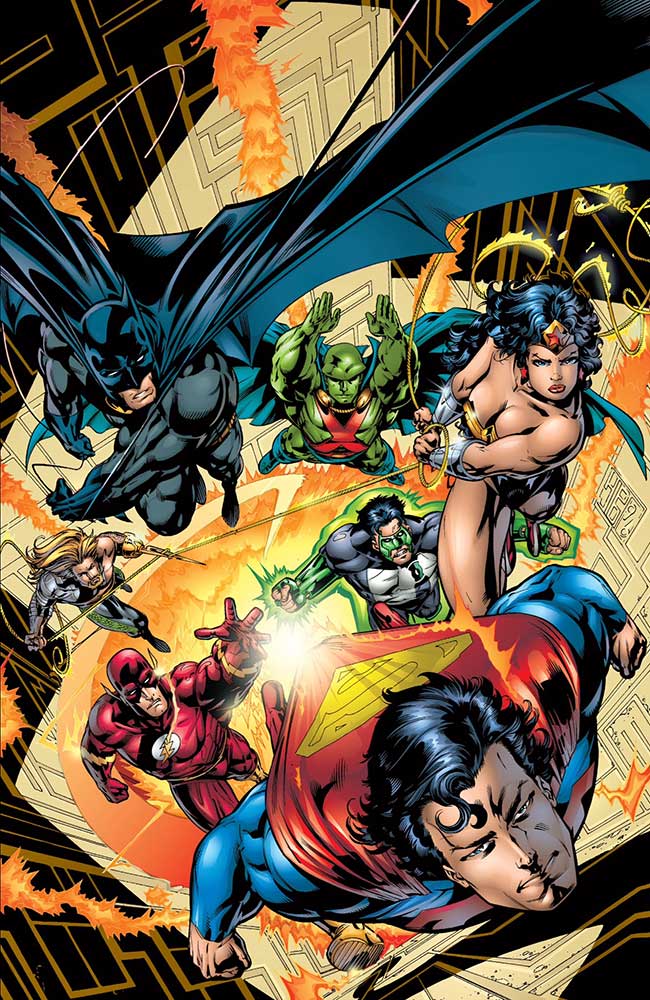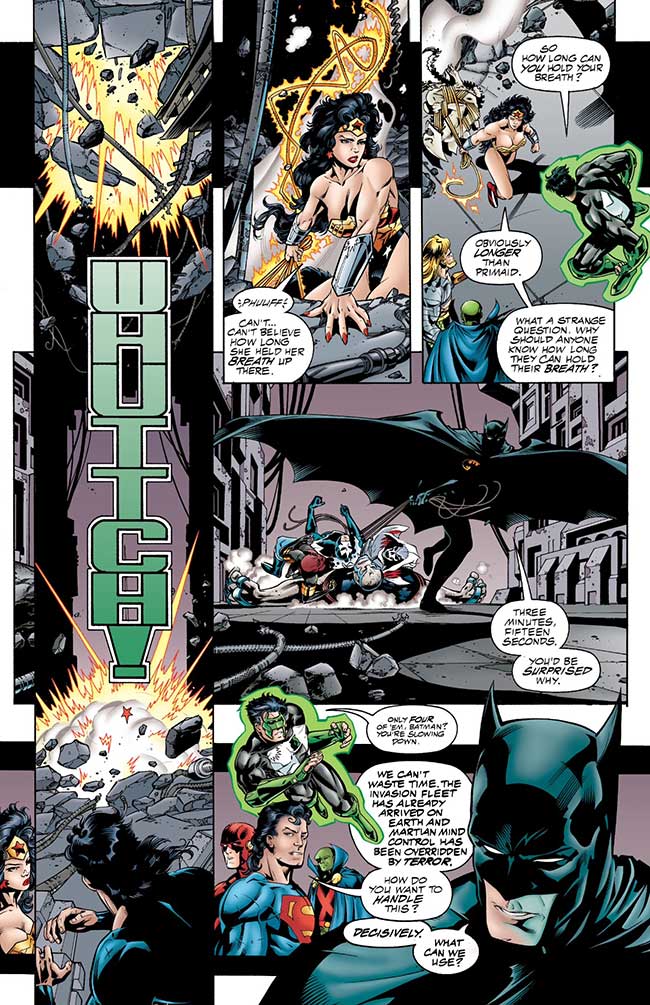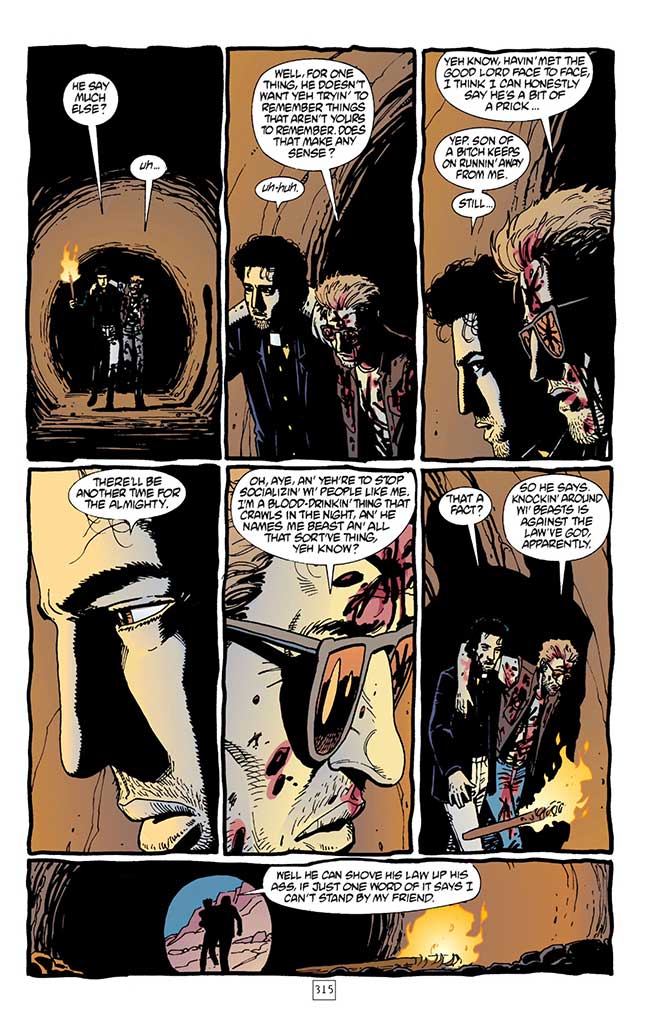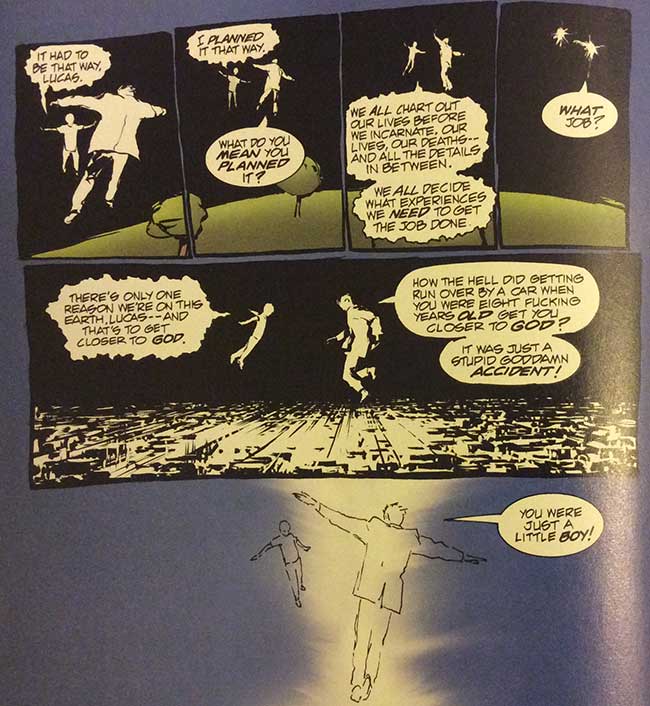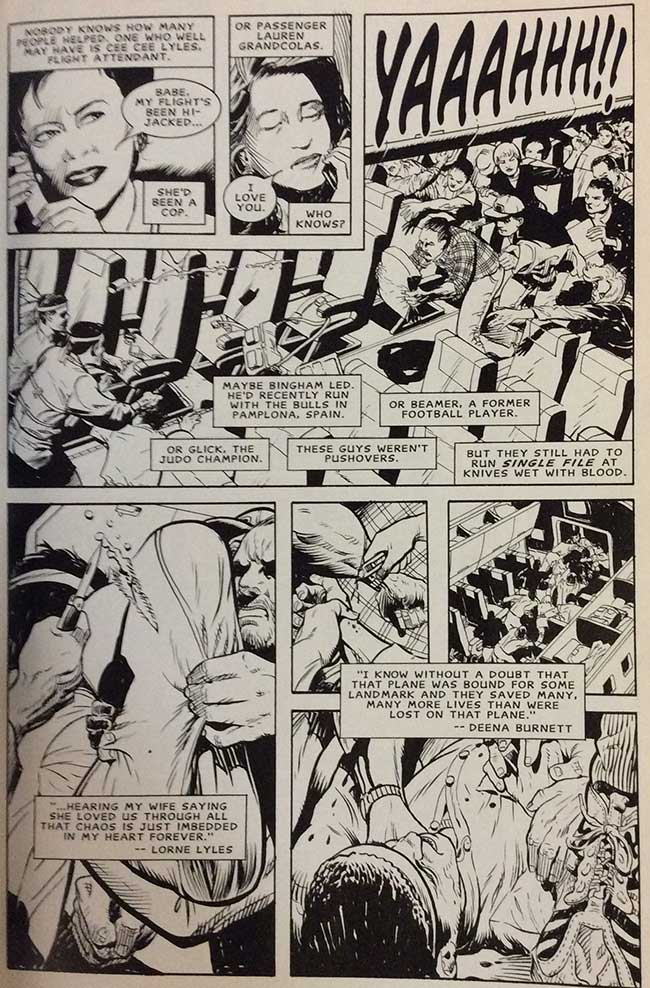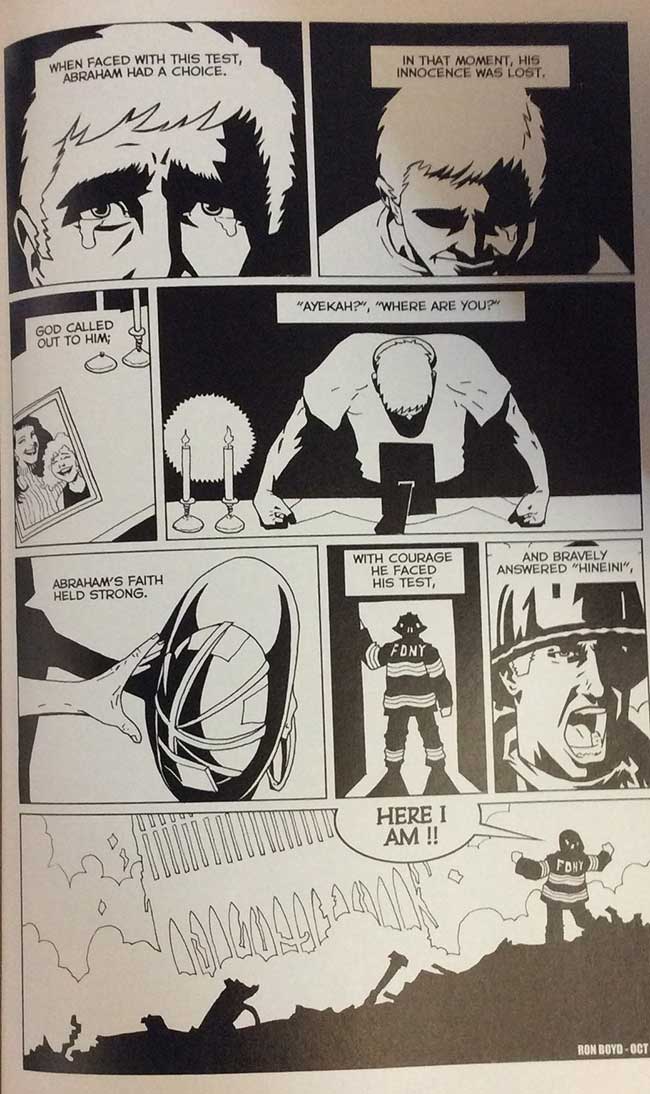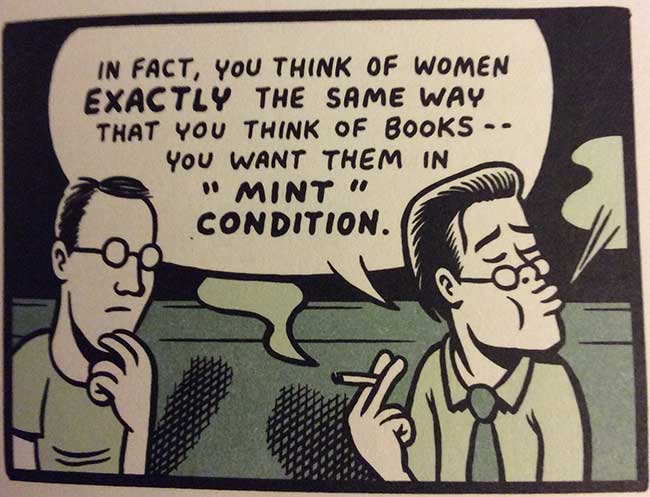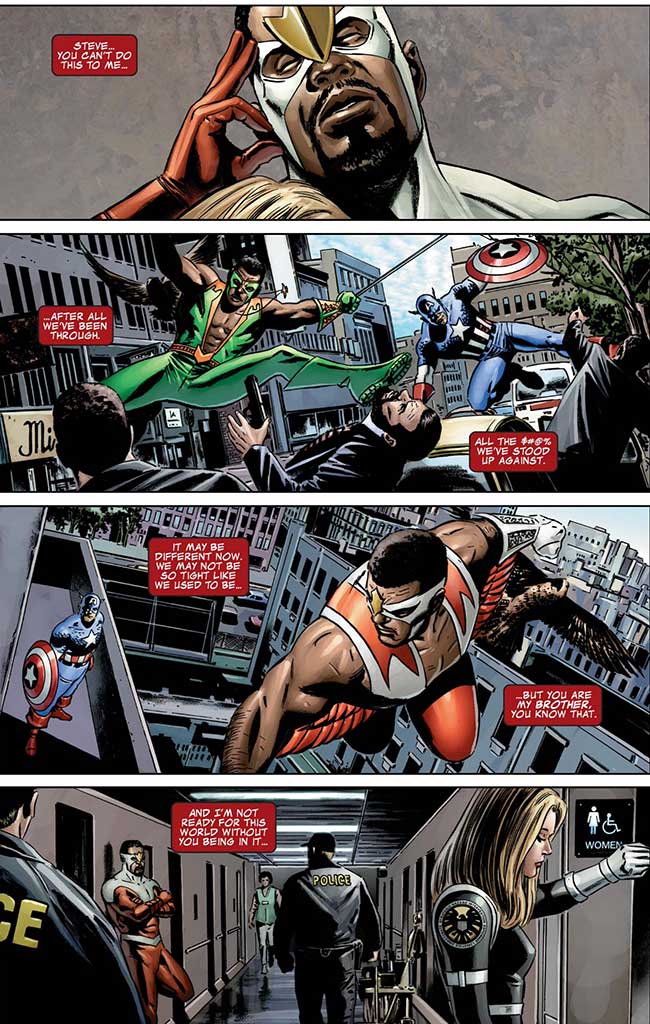Rand is back to share his fond memories of decades of comic collecting and reading in this month’s Random Access Memory.
Author’s Note: Random Access Memory is me looking back at the specific comics that shaped my life. Each month I go back in time – in five year intervals – to examine key comics that came out those months. (The idea is that after five years of monthly columns, I will have covered an entire lifetime – in this case, fifty years – of reading comics.) I also list all the comics I read that particular month. This will afford readers the opportunity to chastise me for not reading specific comics, and/or laugh at the horrible, horrible choices I made in the past.
February 1977
Captain Marvel 50
I wasn’t a regular reader of this book in 1977, but the Avengers were on the cover, so I snatched it up – and was glad I did. The villain of the issue, the Super-Adaptoid, was a pretty blatant rip-off of DC’s Amazo:
The hook of this sort of villain is that the more (and more powerful) heroes you add to the fray, the harder the bad guy is to defeat. But Captain Marvel has an idea.
The brilliance of this is not only did it get rid of the bad guy without further violence, but it also managed to free perennial side-kick Rick Jones from the curse of hanging out in the Negative Zone whenever Captain Marvel was needed. Neat.
Other Comics I Read From February 1977
- Action Comics 471
- Avengers 159
- Batman 287
- Black Lightning 2
- The Brave and the Bold 134
- Defenders 47
- Detective Comics 469
- Superman 311
- Wonder Woman 231
February 1982
Fantastic Four Roast
A rather silly one-shot from 80s Marvel’s humorist-in-residence Fred Hembeck. This is exactly what it sounds like: the heroes of the Marvel Universe put on tuxes and make fun of the Fantastic Four. The book manages to rise above novelty status due to the wonderful idea of having each character (or group) illustrated by their signature artists. So, you get (among many others) Captain America by Mike Zeck:
And Daredevil by Frank Miller:
Best of all, the book ends with a double-page spread illustrated by a who’s who of early 80s comic book artists:
Other Comics I Read from February 1982
- Amazing Spider-Man 228
- Avengers 219
- Captain America 269
- Cerebus 35
- Daredevil 183
- Fantastic Four 242
- Ka-Zar 15
- Marvel Fanfare 2
- Marvel Team-Up 117
February 1987
American Flagg 41
This isn’t the first time I’ve mentioned my love of J. M. DeMatteis’ much-maligned American Flagg run, and it won’t be the last. One of the things I loved about it was conversations like this one:
This was also the first issue of the run to be penciled and inked by Mark Badger. Badger has a very unique art style, and his pencils were not well served by the more traditional inks of Randy Emberlin. Starting with this issue, the art really started to work for me.
DC Science Fiction Graphic Novel 7: Sandkings
My first exposure to George R. R. Martin. This graphic novel adaptation of Martin’s short story – later adapted for television as the first episode of a mid-90s revival of Outer Limits – was pretty solid. And by “solid” I mean engaging and horrifying. I’m not a huge fan of Pat Broderick, but his style really worked on this story.
Justice League 1
The beginning of the Bwahaha era of the Justice League – and one of the most iconic covers of all time. (I’ve lost count of how many times this cover has been parodied.)
One of the best examples of making creative lemonade out of editorial lemons, this Justice League’s roster seemed to be determined more by the “in-flux” status of the more traditional Justice League members – Superman, Wonder Woman, and the Flash were all in the midst of post-Crisis reboots – than by the creator’s desire to work with any specific characters. But Keith Giffen and J. M. DeMatteis took C-list characters like Mr. Miracle, Blue Beetle, Booster Gold, and Guy Gardner’s Green Lantern and made a huge hit comic with them, primarily by playing up the ridiculousness of their being in the Justice League in the first place.
Of course, having Batman to bounce them off of didn’t hurt. From the very first page of the book, Guy Gardner is presented as a total jackass, but also as a major power, and – for a few moments, at least – a serious threat to Batman’s leadership.
And one cannot discuss the popularity of this book without mentioning Kevin Maguire’s pencils. His work with facial expressions – as seen clearly on the cover – is unparalleled. Look at this single panel of Batman boring the rest of the League:
The expectation at the time would have been for the artist to deliver a panel of six heroes sitting around a table, each face drawn with the same tight-lipped, lantern-jawed intensity. Having received this panel, the scripter would then proceed to cover it with thought balloons letting the reader know how bored each character was. “I am so bored,” Blue Beetle would think. “Did I leave the oven on?” J’onn J’onzz would muse. ”Where the #$@%! is Shazam’s head?” Mr. Miracle would wonder. But Maguire’s communicates all that and more, leaving DeMatteis free to write much better jokes.
Watchmen 9
This is, for my money, the issue of Watchmen. If humanity wanted to time vault a single comic book to communicate what sequential art was to the future aliens combing through our remains, Watchmen 9 would certainly make the short list.
Most of this issue takes place on Mars, as Silk Spectre tries to convince Dr. Manhattan to help save a world he no longer believes is worth saving. They have a conversation about thermodynamic miracles, and along the way, Laurie remembers a lot, and realizes a lot more, and Moore and Gibbons structure the storytelling to eerily match how human memory functions.
During their conversation, we flash back to two meetings between Laurie and the Comedian – one before and one after Laurie learns that the Comedian had sexually assaulted her mother.
As the conversation continues, Laurie finally puts the pieces together:
Eventually, the clockwork castle Dr. Manhattan constructed on Mars (and compared favorably to human life) falls – like the snow globe, like the perfume bottle, like the scales from Laurie’s eyes – and he realizes that the thermodynamic miracle he has longed to see has been in front of him all this time.
Yummy Fur 3
Chester Brown has had a very strange career. But before the autobiographical comics, the Louis Reil biography, the Biblical adaptations, and the prostitution apologetics, there was the surrealistic tale of Ed the Happy Clown. Ed’s story seems improvisational – like a one-man jam strip. Each new panel is entirely unpredictable, yet – in hindsight – seems somehow inevitable. Characters are introduced haphazardly – often bafflingly – and yet, eventually, their story function and relationship to Ed is made clear.
Our story begins by introducing a new character.
Luckily Chet works in a hospital and easily finds a surgeon to help him.
And, for reasons never explained, Chet’s hand ends up in Ed’s bed.
This is a story where insane things happen. A lot. And much of the narrative’s horror stems from the characters responding with relative calm in the face of such odd and tragic events. Except poor Ed, of course – who appears to be the only character who understands that this isn’t the way the world should work.
This issue also features the first appearance of “The Man Who Couldn’t Stop.”
This poor man’s unfortunate tale of body horror continues in future issues, and has a profound impact on Ed’s story. Would I lie to you?
Other Comics I Read from February 1987
- Alien Encounters 11
- Amazing Spider-Man 288
- Avengers 279
- Badger 25
- Classic X-Men 9
- Elektra: Assassin 8
- Grendel 5
- Incredible Hulk 331
- Luger 3
- Marvel Fanfare 32
- Nexus 34
- Question 4
- Scout 16
- Swamp Thing 60
- Vigilante 41
- X-Men vs. the Avengers 3
February 1992
Doom Patrol 53
Doing a Lee/Kirby Fantastic Four tribute issue in an early 90s DC comic seemed slightly insane at the time, but Grant Morrison’s had been redefining “slightly insane” for over 30 issues at this point, and his editors weren’t about to pull back the reigns now.
Guest artist Ken Steacy really shines here, using the same photo-collage technique Jack Kirby used for the “cosmic” background images.
It’s all a pretty silly affair – reimagining several Vertigo characters as Silver Age Marvel Heroes for a loose retelling of the Kirby/Lee classic “This Man… This Monster!” – but done with great love. The best bit is probably the geographical location out of which our heroes operate:
And give the man his due: Morrison beat Alan Moore to the punch on this one, as Moore’s 1963 series came out over a year after Doom Patrol 53.
Other Comics I Read from February 1992
- Animal Man 46
- Batman: Legends of the Dark Knight 29
- Beautiful Stories for Ugly Children 26
- Cerebus 155
- Demon 22
- Hellblazer 52
- Incredible Hulk 392
- Peepshow 1
- Peter Parker the Spectacular Spider Man 187
- Sandman 36
- Shade the Changing Man 22
- Swamp Thing 118
- X-Factor 77
February 1997
Hitman 13
One of the more pleasurable aspects of the Hitman series was Ennis and McCrea’s tendency to follow longer, (at least marginally) serious storylines with shorter, entirely silly ones. This was first demonstrated by following the Ten Thousand Bullets and Local Heroes storylines with the two-part “Zombie Night at the Gotham Aquarium.”
If that title’s not enough to pique your interest, I present the following image:
And if that doesn’t make you want to check this comic out, then you and I are very different people.
Invisibles 3
This issue offers a lot of widescreen action and plot development to enjoy, but – for my money – the best bits are more subtle.
The flashback showing King Mob and Jolly Roger learning the White Flame meditation is fascinating.
But I want to focus on this page:
The first issue of the first volume of the Invisibles climaxes with King Mob rescuing Jack, and rather efficiently killing several red shirt/security guard type “bad guys” while doing so. Eleven issues later, Morrison presented the masterful “Best Man Fall,” which devoted an entire issue to exploring the life of one of the security guards that King Mob murdered in the first issue. It was like the single panel of his death in issue one was a hypertext link to the entirely of issue 12. Though it has almost no impact on the story of our main characters, it is nonetheless perhaps the best and most important issue of the entire series, in that it firsts demonstrated that a.) the good guys might not be as good as we think (as well as the corollary notion that the bad guys might not be as bad as we think), and b.) in this story there was no such thing as a minor character.
Now here, twenty-one issues later, King Mob kills another security guard. As before, we know nothing about this person. As far as we’re concerned, this character did not exist before this page. Yet, the bullets that tear into his body exit as five biographical panels – a shorthand version of Best Man Fall.
Just four issues later, King Mob kills another minor character, and the sequence is further edited down to King Mob’s single line “You look like someone with an interesting story to tell.”
JLA 4
The finale of Grant Morrison’s initial JLA arc. This one has perhaps my favorite three-page action sequence of all time, as Morrison provides character-defining moments for most of the team:
We begin with further exploration of the “frenemy” relationship Morrison created between the Flash and Green Lantern, the two legacy characters on his team. Then the page flows perfectly from that scene to a wonderful Aquaman sequence:
Morrison was the first to capitalize on the friendship that would inevitably develop between Aquaman and Wonder Woman, as both were royalty. Also, both are total badasses.
Turning to the third page, we get the end of the Wonder Woman sequence, which leads to a perfect Batman entrance.
This issue also ends with a (perhaps the) perfect Superman moment. Speaking as much for the reader as themselves, Wonder Woman and the Flash question the purpose of reactive Super-Heroics, and Superman’s sublime response sets the tone for the entirely of Morrison’s run on JLA.
Indeed, it works as a thesis statement for all of Morrison’s turn-of-the-century work: Super-Heroes aren’t there to solve our problems but rather to inspire us to solve them ourselves.
Preacher 24
I’ve said before that each issue of Preacher has at least one perfect page. This issue has two.
Jesse doesn’t preach the Word of God so much as he has the Word of God. All who hear his voice are compelled to do whatever he says. At this point in the story, the only thing stopping Jesse from rescuing his friend Cassidy is a man with a rifle, and he’s got the drop on Jesse.
Later, Jesse and Cassidy discuss Cassidy’s encounter with “the LORD,” as they make their escape:
Seekers 15
Creator J. M. DeMatteis described his only ongoing Vertigo series Seekers: Into the Mystery as “The X-Files meets the Celestine Prophecy.” These days, one might question the value of that cross-roads, but in the mid-90s that really should have been a license to print money. Sadly, Seekers was cancelled long before DeMatteis was able to finish what I’m sure would have been a satisfying novel-length story. I’ve often thought back to this series and imagined DeMatteis would return to the story with another publisher, and to this day I live in hope.
Here are a few great pages from the final issue. Lucas is confronted by the spirit of his younger brother:
Lucas has a revelation at the tomb of the Magician – that’s actual former human (and, depending on your point of view, Avatar of God) Meher Baba, in case you didn’t know.
The entire 15 issue series (with wonderful art by Glenn Barr, Michael Zulli, Jill Thompson, and Jon J. Muth) was recently put back into print by Dover Publications, and will be available digitally later this year.
Other Comics I Read from February 1997
- Aztek 9
- Batman: Legends of the Dark Knight 93
- Batman: The Long Halloween 5
- Black Lamb 6
- Cerebus 215
- Darkness 3
- DV8 4
- Flash 124
- Hate 26
- Hellblazer 112
- Impulse 24
- Kurt Busiek’s Astro City 5
- Leave it to Chance 4
- The Shade 1
- Spectacular Spider-Man 245
- Starman 29
- Stormwatch 45
- Strangers in Paradise 3
- Unknown Soldier 1
- Untold Tales of Spider-Man 20
- Wildcats 33, 34
February 2002
9-11: Artists Respond vol. 1 (Dark Horse/Image)
This is the companion volume to the DC collection I spoke of last month. As the “indy” publication, this volume skewed slightly more serious/realistic (i.e., no super-heroes). There is a lot to like here, the examples below providing only a sampling of the great material contained in this volume.
Paul Chadwick’s sober reporting – put together from transcripts of cell calls – of what took place before the crash of United Airlines Flight 93 is made more powerful by its subdued tone.
All artists should take note of Chadwick’s subtle, honest storytelling.
Jon J. Muth offers a beautiful painting and a prayer for peace:
Ron Boyd’s “Ayekah” speaks for itself:
But it is Alan Moore and Melinda Gebbie’s six-page “This is Information” that stands as the most powerful and lasting comics statement created in the immediate wake of the events of September 11, 2001.
Moore’s tone is academic, but not emotionless. In fact, the tone is softer (and less knowingly cynical) than the majority of his work – and the sense of love and hope that pervades the piece is nice to see from the alleged Father of comics’ grim and gritty Dark Age.
In six pages, Moore discusses morality, the ethics of war, terrorism, sociology, and religion – and how all of that is affected by multiculturalism and the media. Yet he still finds time to center us on what is important. The left hand extending from the wreckage could be any race. Any gender. Any religion. At this frozen moment, we cannot afford to care whether the hand is connected to one of “us” or one of “them.” We simply reach out to let them know that we are present. We are there for them. We are there with them.
Moore’s sober meditation on religion, violence, and media was recently republished – along with nine other hard to find Moore short comics – in the volume Brighter Than You Think.
Authority 28
Ground zero for the Grant Morrison/Mark Millar feud. Two of the most popular and important writers in modern comics, Millar and Morrison used to be the best of friends. Throughout the 90s, they wrote, did interviews, and hung out together. Then, shortly into the 21st century, it became clear that their friendship had ended. Some assumed that the older Morrison was jealous of Millar’s growing success, especially his ability to get his comics made into Hollywood features. Others claimed that Morrison simply grew tired of Millar’s lowest common denominator storytelling. Neither has been forthcoming, so it’s likely no one will ever know the finer details, but one thing we know for sure is that Millar was upset that Morrison shared publicly that he ghost-wrote issue 28 of the Authority.
Not being privy to whatever agreement they may have had regarding the ghost-writing, I can’t speak to whether Morrison crossed a line, or Millar was simply being oversensitive about his reputation as Morrison’s understudy – when Millar left Ultimate X-Men, his editor quipped that “Grant Morrison ran out of ideas” – but I can say that when I first read this issue, it was pretty clear to me that Morrison had written at least part of it.
Those pages scream Morrison. Does anyone really think Millar would (or could) write phrases like “memetically-engineered, all-purpose pop god”? And “Religimon”? If Millar had that idea, we would have been subjected to a six-issue Millarworld Religimon series and a Matthew Vaughn-directed feature film.
Peepshow 13
Joe Matt’s record for issues per year stands at three, and by the time the eighth issue of Peepshow came out, we were lucky to get one issue a year out of him. In fact, we haven’t seen an issue since 14 came out in the fall of 2006.
This is the third issue of a four-issue storyline that – literally – consisted of alternating scenes of Joe Matt hanging out with (friends and fellow cartoonists) Seth and Chester Brown, Joe Matt masturbating, and Joe Matt editing porn videos for future masturbation. It’s a true testament to Matt’s level of storytelling craft that he could manage to make such a comic readable, let alone compelling.
Thankfully, this issue is devoted entirely to a diner conversation between Matt, Brown, and Seth. Matt is always quick to present himself as neurotically cheap – displayed here by his unwillingness to order food while his friends eat lunch. Then Brown’s discussion of a scientific experiment hits a little close to home:
While much of the issue is devoted to documenting how his friends make fun of him without mercy, the conversation turns to a more reasonable analysis of Matt’s problems – most notably his preference for pornography over actual sex. Seth’s comparison of Matt’s attitudes toward woman and comics is particularly astute.
Other Comics I Read from February 2002
- 100 Bullets 33
- Alias 6
- Avengers 51
- Avengers: Celestial Quest 6
- Batman 600
- Batman: Legends of the Dark Knight 152
- Cage 1
- Catwoman 4
- Daredevil 30
- Dark Knight Strikes Again 3
- Detective Comics 767
- Elektra 8
- Flash 183
- Four Women 5
- Fury 6
- Hellblazer 171
- Incredible Hulk 37
- JSA 33
- Lucifer 23
- Midnight Nation 10
- New X-Men 123
- Promethea 19
- Spider-Man’s Tangled Web 11
- Superman Adventures 66
- Tom Strong 16
- Tomorrow Stories 12
- Transmetropolitan 53
- Ultimate Marvel Team-Up 13
- Ultimate Spider-Man 18, 19
- Ultimate X-Men 115
- Ultimates 2
- Wolverine/Hulk 1
- X-Force 125
February 2007
Brave and the Bold 1
Mark Waid and George Perez’ revival of the Brave and the Bold was a lot of fun. Traditional team-up comics focus on one character (e.g., Batman) teaming up with another hero (e.g., Green Lantern) every issue. This works so long as the team solves the crime by the end of the issue. If not, we are left wondering why Batman is continuing the case, but –suddenly – teaming-up with Black Lightning to do so. Here Waid ambitiously attempts to tell a larger, interlocking story using the “team-up” format – and succeeds by choosing to follow the McGuffin and not the character.
We open with Green Lantern encountering a mystery in space. Quite reasonably, he calls on the JLA’s resident detective:
And we reveal an image so unexpected that it almost makes me feel bad about not spoiling the mystery.
Captain America 25
The Death of Captain America. After the lackluster ending of Civil War, this issue would probably have made for a powerful epilogue, had Marvel not decided to spoil the ending via every major media outlet the morning the issue was released. Don’t get me wrong, it worked – the comic sold through the roof, and even netted Joe Quesada an appearance on The Colbert Report.
But I can’t imagine that any adult thought that Steve Rogers’ “death” would stick. It did, however, provide for some great stories, especially as writer Ed Brubaker seemed more comfortable with Bucky’s more violent/compromised Cap than he did with Steve. It also provided an opportunity to shine some light on the able supporting cast of the book. Sam Wilson, in particular, benefited from the shake-up.
The comic also gave us one of the most iconic panels of the 21st century:
Other Comics I Read from February 2007
- 100 Bullets 81
- 52 40-43
- American Virgin 12
- Avengers: Earth’s Mightiest Heroes II 7
- Batman 663
- Bullet Points 4
- Civil War: The Initiative
- Criminal 5
- Crossing Midnight 4
- Casanova 7
- Daredevil 94
- DMZ 16
- Dr. Strange: The Oath 5
- Exterminators 14
- Fell 7
- Ghost Rider: Trail of Tears 1
- Green Lantern 17
- Hellblazer 229
- Incredible Hulk 103
- Invincible 41
- JSA 3
- Loveless 16
- Midnighter 4
- New Avengers 27
- Nightly News 4
- Other Side 5
- Powers 25
- Punisher Presents Barracuda 1
- Punisher War Journal 4
- Scalped 2
- She-Hulk 16
- Stormwatch PHD 4
- Teen Titans 44
- Testament 15
- Thunderbolts 111
- Ultimate Spider-Man 105
- Wonder Man 3
- X-Factor 16
- Y: The Last Man 54
February 2012
Punisher Max 22
One of the better conceits of Garth Ennis’ Punisher Max run was that he aged in real time. Frank Castle fought in Vietnam. Therefore, Frank Castle was in his sixties. Jason Aaron agreed to take over the book on the conditions that a.) he could continue to write the character as Ennis envisioned him, and b.) he would be allowed to kill him at the end of his run. Editorial said yes, and as a result Jason Aaron and Steve Dillon gave us a remarkable 22 issue stand-alone Punisher novel.
This final issue is an epilogue, taking place after Frank’s death, and narrated by Nick Fury.
The issue ends in what I gather was meant to be a positive beat – the Punisher may be dead, but his legacy lives on…
Bearing in mind that the Max version of Nick Fury – like the Punisher, as defined and fleshed out by Garth Ennis – is a much nastier piece of work than his 616 or Ultimate universe counterparts, I read this as a full-on horror story ending.
Other Comics I Read from February 2012
- Action Comics 6
- Activity 3
- Amazing Spider-Man 679, 680
- American Vampire 24
- Animal Man 6
- Aquaman 6
- Astonishing X-Men 47
- Avengers 22, 23
- Avengers Academy 25, 26
- Avenging Spider-Man 4
- Batman 6
- Batman and Robin 6
- Batwoman 6
- Brilliant 8
- Captain America 8
- Chew 24
- Daredevil 9
- Dark Horse Presents 9
- Deadpool Max II 5
- Defenders 3
- Fantastic Four 603
- FF 15
- Frankenstein: Agent of SHADE 6
- Green Lantern 6
- Green Lantern Corps 6
- Green Wake 10
- Grifter 6
- Hellblazer 288
- Invincible 88
- Invincible Iron Man 513
- Journey into Mystery 634
- Justice League 6
- Justice League Dark 6
- Mighty Thor 11
- Moon Knight 10
- New Avengers 21, 22
- Punisher 8
- Scalped 56
- Six Guns 5
- Swamp Thing 6
- Sweet Tooth 30
- Ultimate Comics Ultimates 7
- Uncanny X-Men 6, 7
- Walking Dead 94
- Winter Solider 1, 2
- Wolverine 301
- Wolverine and the X-Men 5
- Wolverine and the X-Men: Alpha and Omega 2
- Wonder Woman 6
- X-Factor 231, 232
- X-Men Legacy 262
Dear Spoilerite,
At Major Spoilers, we strive to create original content that you find interesting and entertaining. Producing, writing, recording, editing, and researching requires significant resources. We pay writers, podcast hosts, and other staff members who work tirelessly to provide you with insights into the comic book, gaming, and pop culture industries. Help us keep MajorSpoilers.com strong. Become a Patron (and our superhero) today.



